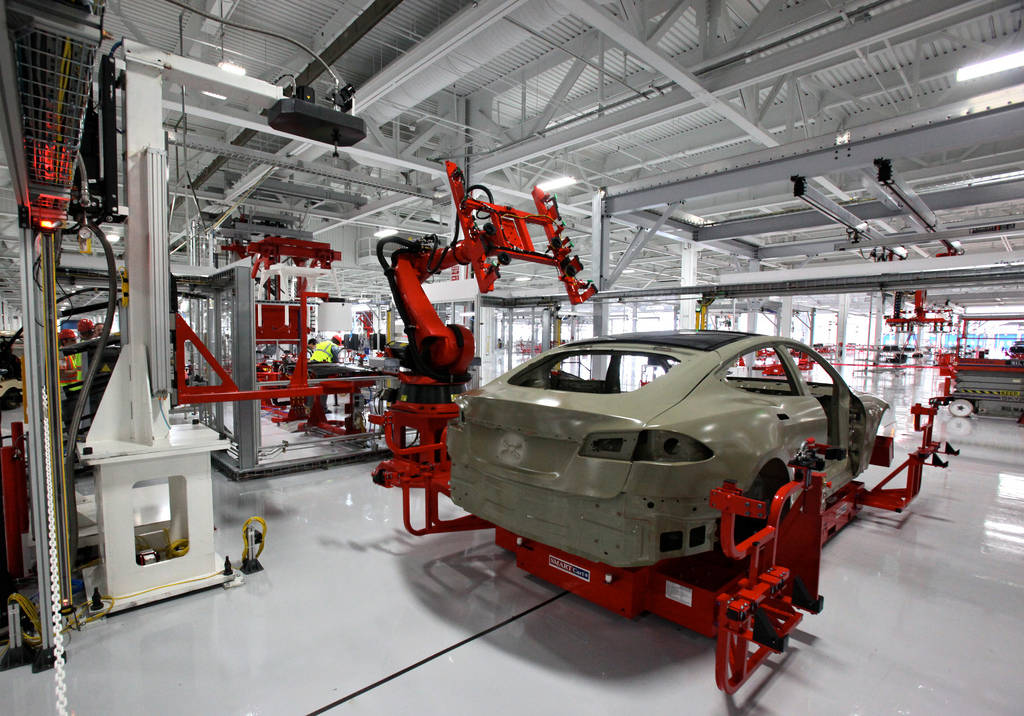[Photograph - Tesla Autobots by Steve Jurvetson under Creative Commons]
Whether you look at England, the United States and Germany, or, more recently, Japan, Taiwan or South Korea, no country has climbed the economic ladder to prosperity without many years of manufacturing-driven growth. The factory allows people to shift from cultivating land to industrial activities that are much more productive, and this results in an increase in “value-added” that contributes to the prosperity of the country and its people. Manufacturing also generates a large number of related and auxiliary jobs right across the value chain. This is the reason that, for years now, Indian policy makers have been concerned about the decline in manufacturing which currently accounts for only 15% of India’s GDP.
To address the manufacturing challenge, the previous government set up a National Manufacturing Competitiveness Council which started new programmes focused on quality and clusters. This one has taken the focus on manufacturing one step further by starting a national Make in India campaign and complementing it with a Skill India campaign that is intended to develop the trained manpower that will enable Make in India to work. The hope is that with higher wages impairing China’s competitiveness, India can take China’s place as the factory of the world.
However, in all of this, there hasn’t been much discussion about what manufacturing will look like in the future. Instead, I see an implicit assumption that manufacturing will remain largely the same as it has been in the recent past.
But, making this assumption could be a terrible mistake.
Manufacturing is at an inflection point
Martin Ford’s The Rise of the Robots: Technology and the Threat of Mass Unemployment (Oneworld Publications, 2015) is a fascinating account of how increasing automation is changing the nature of manufacturing and of services across the world.
Ford’s thesis is simple. He starts by pointing out that while the productivity of manufacturing rose steadily in the 20th century, there was a major qualitative difference in two phases. Prior to the first Oil Shock, productivity increases came from electrical and mechanical improvements, and the benefits of productivity increases were matched by increased wages to workers. However, from the 1980s onward, productivity increases have been largely due to information technology and the beneficiaries have been owners and the investors in capital, not those working on the shop floor.
Thanks to technological advancement, there has been a big jump in the nature of tasks that machines can do. Earlier, machines lacked dexterity and intelligence. But now, thanks to developments in artificial intelligence and machine learning, and the huge decrease in the cost of computing thanks to the relentless march of Moore’s law (where the power of computers doubles every 18 months), machines can do a whole new set of tasks that earlier either had to be done by people or required human intervention. Ford provides several examples, but I was particularly captivated by a story from Japan about a completely automated sushi restaurant.
The third dimension of this change is the declining cost of automation, including robots. Ford points out that like the android phone, robots are moving away from proprietary operating systems and programming languages to open source programs that make robots easier to program at a lower cost. This is bound to accelerate the diffusion of robots.
But, is this for real?
It would be easy to dismiss all of this as science fiction, alarmism or as irrelevant to India. But that would be a mistake. Several pieces of disparate evidence that Ford provides underline this.
In recent years, there have been several reports of the return of some manufacturing activities to the developed world, particularly to the US. This has worked because of the combination of lower costs of automation with the advantages of manufacturing close to the market—this is particularly useful in industries such as apparel where reducing lead times is beneficial as tastes can change at short notice, and the costs of “fashion misses” is high.
China already has the largest number of robots in the world. Automation is thus clearly an integral part of the kind of manufacturing that we in India hope to do.
Leaders of the IT services industry have repeatedly spoken about how automation is the next big thing in their industry as top line growth rates slow down and people costs remain high.
The jobs that India is targeting through foreign direct investment are primarily those that can be offshored or outsourced. But it is this same set of jobs that is repeatable and programmable, and hence most vulnerable to automation.
In India itself, several studies show that our impressive growth since liberalization has not been accompanied by the expected growth in employment. While this may not be due to automation alone, it is clear that a combination of capital investment in technology and the casualization of labour is stunting the growth of labour in the organized sector.
Ford also points out the irony that the average capitalist would prefer a pliable robot to an idiosyncratic human being any day!
Other relevant trends
Ford draws our attention to several paradoxes inherent in the current evolution of Western economies in general and the United States in particular. While there are jobs, and unemployment rates may have returned back to the levels before the 2007-08 economic recession, these jobs are mainly low-level service jobs that offer absolutely no guarantee of continuing employment and, at best, subsistence wages. More people may be acquiring college degrees but they are invariably over-qualified for their jobs. Except in industries like healthcare and taking care of the old, there are few “good” jobs. In this scenario, Ford asks where will the consumers of tomorrow come from? Don’t forget that the US is the world’s largest consumer economy and the powerhouse of the global economy.
Basically, growth and wealth have got delinked from employment and jobs.
In the US, there has been a tendency to see the employment problem as one of retraining people so that they can do higher level jobs. But, the number of such jobs is not large, and in any case many people lack the basic knowledge to be re-trained for such occupations.
What this means for us
Technological progress is a mixed blessing. We may love our android phones and all that they do, but the same technological progress is changing the nature of work in ways we don’t realize.
Automation can’t be stopped by fiat or regulation. And, with our weak record in capital goods development and manufacture, we are unlikely to become the centre of production of the means of automation.
My takeaway is simple. Our push into manufacturing will take time to fructify. If we want it to be successful, we need to prepare for manufacturing as it will be five years from now, not the way it was five years ago. And, given the rapid changes happening in manufacturing, we should be cognizant that manufacturing by itself is no panacea for our challenges of economic and job market growth.
The Rise of the Robots should be essential reading for every policy maker, economist or CXO in the country.
[These are the personal views of the author]


